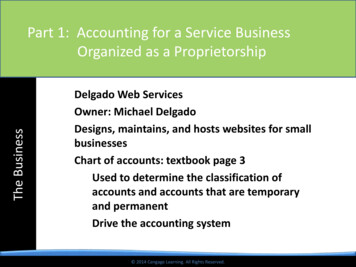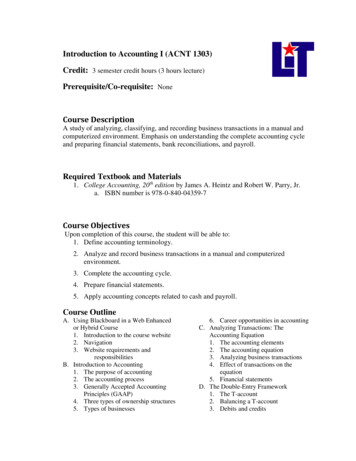
Transcription
The BusinessPart 1: Accounting for a Service BusinessOrganized as a ProprietorshipDelgado Web ServicesOwner: Michael DelgadoDesigns, maintains, and hosts websites for smallbusinessesChart of accounts: textbook page 3Used to determine the classification ofaccounts and accounts that are temporaryand permanentDrive the accounting system 2014 Cengage Learning. All Rights Reserved.
Guiding QuestionsSetting the StageHow many of you are entrepreneurs?How many of you are employees?How do you know the difference?How many of you know someone who works in theaccounting field?Who do you think uses accounting information?How many of you have a job that provides a paycheck?- Accurate records for each employee are important 2014 Cengage Learning. All Rights Reserved.
Learning ObjectivesLO1 Describe the different users of accountinginformation.LO2 Prepare a net worth statement and explainits purpose. 2014 Cengage Learning. All Rights Reserved.
Lesson 1-1The Role of AccountingLO1 Data must be recorded and reported inaccounting reports. Then, the information can be provided tobusiness owners, managers, investors, andothers to make business decisions andmeasure performance. 2014 Cengage Learning. All Rights Reserved.SLIDE 4
Lesson 1-1What Is Accounting?LO1 Accounting is the process of planning, recording,analyzing, and interpreting financial information. An accounting system is a planned processdesigned to compile financial data andsummarize the results in accounting records andreports. Financial reports that summarize the financialcondition and operations of a business are calledfinancial statements. 2014 Cengage Learning. All Rights Reserved.SLIDE 5
Lesson 1-1Accounting in Personal LifeLO2 A net worth statement allows the person extendingthe loan to see the financial position of a borroweron a specific date and make a lending decision. Anything of value that is owned is called an asset. An amount owed is called a liability. The difference between personal assets andpersonal liabilities is called personal net worth. In business, net worth is also called equity. Equity is the difference between assets andliabilities. 2014 Cengage Learning. All Rights Reserved.SLIDE 6
The Accounting EquationAssets - Liabilities Owner’s Equity (net worth)The equation shows the relationship amongitems of value a person has and the financialrights to the items 2014 Cengage Learning. All Rights Reserved.SLIDE 7
Lesson 1-1Personal Net Worth StatementLO2123Total Assets1 (owned) Total Liabilities2 (owed) 3 Net Worth(also known as Equity) 2014 Cengage Learning. All Rights Reserved.SLIDE 8
Lesson 1-1Ethics in BusinessLO2 The principles of right and wrong that guidean individual in making decisions are calledethics. The use of ethics in making business decisionsis called business ethics. 2014 Cengage Learning. All Rights Reserved.SLIDE 9
Lesson 1-1Lesson 1-1 Audit Your Understanding1. What is accounting?ANSWERAccounting is the process of planning,recording, analyzing, and interpretingfinancial information. 2014 Cengage Learning. All Rights Reserved.SLIDE 10
Lesson 1-1Lesson 1-1 Audit Your Understanding2. Why is accounting called the language ofbusiness?ANSWERAccounting provides financial informationto everyone who needs it to make goodbusiness decisions. 2014 Cengage Learning. All Rights Reserved.SLIDE 11
Lesson 1-1Lesson 1-1 Audit Your Understanding3. Describe a scenario in which you, as anonaccountant, might use accounting.ANSWERAnswers may include creating a personalbudget or providing information for a loanor credit card application. 2014 Cengage Learning. All Rights Reserved.SLIDE 12
Lesson 1-1Lesson 1-1 Work Together & On Your Own3. Textbook page 9ANSWER 2014 Cengage Learning. All Rights Reserved.SLIDE 13
Learning ObjectivesLO3 Classify accounts as assets, liabilities, orowner’s equity and demonstrate theirrelationship in the accounting equation.LO4 Analyze the effects of transactions on theaccounting equation.LO5 Distinguish between cash and on accounttransactions. 2014 Cengage Learning. All Rights Reserved.
Brainstorm What are some situations in which having thesame standards or rules is necessary? What are some assets the school would own? What is the accounting equation? If an amount is added or subtracted from oneside of the equation, what must be done tokeep the equation equal? 2014 Cengage Learning. All Rights Reserved.SLIDE 15
Financial Literacy Rule of 72 2014 Cengage Learning. All Rights Reserved.SLIDE 16
Lesson 1-2The Business—Delgado Web Services A business that performs an activity for a fee iscalled a service business. A proprietorship is a business owned by oneperson. A proprietorship is sometimes referred to as a soleproprietorship. Why would a business organize as a proprietorship? Characteristics A business plan is a formal written documentthat describes the nature of a business and how itwill operate. (Delgado’s plan. P10) 2014 Cengage Learning. All Rights Reserved.SLIDE 17
Lesson 1-2Accounting Standards and Rules The standards and rules that accountantsfollow while recording and reporting financialactivities are commonly referred to asgenerally accepted accounting principles orGAAP. Some examples of GAAP concepts you will beaccountable for learning and applying toassignments 2014 Cengage Learning. All Rights Reserved.SLIDE 18
Unit of MeasurementBusiness activities are stated innumbers that have common values. 2014 Cengage Learning. All Rights Reserved.SLIDE 19
Business EntityA business’s financial information isrecorded and reported separately fromthe owner’s personal financialinformation 2014 Cengage Learning. All Rights Reserved.SLIDE 20
Lesson 1-2The Accounting EquationLO3 Financial rights to the assets of a business arecalled equities. The amount remaining after the value of allliabilities is subtracted from the value of allassets is called owner’s equity. The equation showing the relationship amongassets, liabilities, and owner’s equity is calledthe accounting equation. 2014 Cengage Learning. All Rights Reserved.SLIDE 21
Lesson 1-2The Accounting Equation 2014 Cengage Learning. All Rights Reserved.LO3SLIDE 22
Lesson 1-2Receiving CashLO4 Accountants call any business activity that changesassets, liabilities, or owner’s equity a transaction. A record that summarizes all the transactionspertaining to a single item in the accounting equationis called an account. The name given to an account is called an accounttitle. The difference between the increases and decreases inan account is called the account balance. An account used to summarize the owner’s equity in abusiness is called a capital account. 2014 Cengage Learning. All Rights Reserved.SLIDE 23
Lesson 1-2Receiving CashLO4Transaction 1January 2. Received cash from owner as an investment, 2,000.00. 2014 Cengage Learning. All Rights Reserved.SLIDE 24
Lesson 1-2Paying CashLO4Transaction 2January 2. Paid cash for supplies, 165.00.Transaction 3January 3. Paid cash for insurance, 900.00. 2014 Cengage Learning. All Rights Reserved.SLIDE 25
Lesson 1-2Transactions on AccountLO5 A person or business to whom a liability isowed is called a creditor. 2014 Cengage Learning. All Rights Reserved.SLIDE 26
Lesson 1-2Transactions on AccountLO5Transaction 4January 5. Bought supplies on account from Canyon Office Supplies, 220.00Transaction 5January 9. Paid cash on account to Canyon Office Supplies, 100.00. 2014 Cengage Learning. All Rights Reserved.SLIDE 27
Lesson 1-2Lesson 1-2 Audit Your Understanding1. Give two examples of service businesses inyour area.ANSWERAnswers should include businesses thatperform activities for a fee, such as drycleaners, car washes, or landscapers. 2014 Cengage Learning. All Rights Reserved.SLIDE 28
Lesson 1-2Lesson 1-2 Audit Your Understanding2. What must be done if a transaction increasesthe left side of the equation?ANSWERThe right side must also be increased. 2014 Cengage Learning. All Rights Reserved.SLIDE 29
Lesson 1-2Lesson 1-2 Audit Your Understanding3. How can a transaction affect only one side ofthe equation?ANSWERIf one account is increased, anotheraccount on the same side of the equationmust be decreased by the same amount. 2014 Cengage Learning. All Rights Reserved.SLIDE 30
Lesson 1-2Lesson 1-2 Audit Your Understanding4. What does the term on account mean?ANSWERPurchasing on account means buying itemsor services and paying for them at a futuredate. 2014 Cengage Learning. All Rights Reserved.SLIDE 31
Lesson 1-2Lesson 1-2 Work Together & On Your OwnTextbook Page 17Log into ApliaANSWER 2014 Cengage Learning. All Rights Reserved.SLIDE 32
Lesson 1-2Lesson 1-2 Review & AssignmentHow might I evaluate the financial health of abusiness based on the accounting equation?A L OE30 10 ? 15 12ASSIGNMENT62 ? 11Application problem 1-2Application Problem 1-3 2014 Cengage Learning. All Rights Reserved.SLIDE 33
Learning ObjectivesLO6 Compare and contrast the types oftransactions that increase and decreaseowner’s equity.LO7 Explain the difference between expensesand liabilities. 2014 Cengage Learning. All Rights Reserved.
Lesson 1-3Transactions Affecting Owner’s EquityLO6 An increase in equity resulting from the sale ofgoods or services is called revenue. A sale for which payment will be received at alater date is called a sale on account. 2014 Cengage Learning. All Rights Reserved.SLIDE 35
Lesson 1-3Transactions Affecting Owner’s EquityLO6Transaction 6January 10. Received cash from sales, 1,100.00.Transaction 7January 12. Sold services on account to Main Street Services, 500.00. 2014 Cengage Learning. All Rights Reserved.SLIDE 36
Lesson 1-3Transactions Affecting Owner’s EquityTotal of left side: 1,935 500 385 900 3,720 2014 Cengage Learning. All Rights Reserved.LO6Total of right side: 120 3,600 3,720SLIDE 37
Lesson 1-3Expense TransactionsLO7 Unlike a liability, which is an amount that isowed, the cost of goods or services used tooperate a business is called an expense. 2014 Cengage Learning. All Rights Reserved.SLIDE 38
Lesson 1-3Expense TransactionsLO7Transaction 8January 12. Paid cash for communications bill for cell phone and Internetservice, 80.00. 2014 Cengage Learning. All Rights Reserved.SLIDE 39
Lesson 1-3Expense TransactionsLO7Transaction 9January 13. Paid cash for equipment rental, 400.00. 2014 Cengage Learning. All Rights Reserved.SLIDE 40
Lesson 1-3Other Cash Transactions Assets taken from the business for theowner’s personal use are called withdrawals. 2014 Cengage Learning. All Rights Reserved.SLIDE 41
Lesson 1-3Other Cash TransactionsTransaction 10January 16. Received cash on account from Main Street Services, 200.00.Transaction 11January 16. Michael Delgado withdrew equity in the form of cash, 350.00. 2014 Cengage Learning. All Rights Reserved.SLIDE 42
Lesson 1-3Summary of Changes in Owner’s EquityTransactionKind ofNumberTransaction6Revenue (cash)789Revenue (on account)Expense (communications)Expense (equipment rental)11Withdrawal of equityNet change in owner’s equity 2014 Cengage Learning. All Rights Reserved.Change inOwner’s Equity 1,100.00 500.00–80.00–400.00–350.00 770.00SLIDE 43
Lesson 1-3Lesson 1-3 Audit Your Understanding1. How is owner’s equity affected when cash isreceived from sales?ANSWEROwner’s equity is increased. 2014 Cengage Learning. All Rights Reserved.SLIDE 44
Lesson 1-3Lesson 1-3 Audit Your Understanding2. How is owner’s equity affected when servicesare sold on account?ANSWEROwner’s equity is increased. 2014 Cengage Learning. All Rights Reserved.SLIDE 45
Lesson 1-3Lesson 1-3 Audit Your Understanding3. How is owner’s equity affected when cash ispaid for expenses?ANSWEROwner’s equity is decreased. 2014 Cengage Learning. All Rights Reserved.SLIDE 46
The Accounting Equation Financial rights to the assets of a business are called equities. The amount remaining after the value of all liabilities is subtracted from the value of all assets is called owner's equity. The equation showing the relationship among assets, liabilities, and owner's equity is called the accounting equation. LO3











